
Rubik's Slide electronic puzzle game is a Rubik's-branded combination puzzle produced by TechnoSource in 2010. Players must manipulate the circuit to re-create a specified pattern, with 10,000 puzzles built into the device. [1]

Rubik's Slide electronic puzzle game is a Rubik's-branded combination puzzle produced by TechnoSource in 2010. Players must manipulate the circuit to re-create a specified pattern, with 10,000 puzzles built into the device. [1]

The puzzle is based around a 3x3 grid of translucent panels, each panel being illuminated from below with red and blue LEDs. The bank of panels is mounted on a central spring-loaded pivot that can both slide a short distance in each of the four cardinal directions, as well as rotate or yaw slightly around the pivot. Each Slide and Twist maneuver triggers a change in the game's state.
The CPU selects a random pattern of lights as the goal state, then it selects another random pattern of lights as the starting state. The latter pattern visibly illuminates the panels. The goal pattern can be viewed at will by holding a button on the side of the device. Reaching the goal states scores a point, and the CPU generates a new puzzle.
A Slide maneuver will shift all rows or columns one space in the direction of the push. Rows or columns that are shifted off the visible play area "wrap around" to the opposite side. A Twist maneuver's effect varies based on the difficulty setting.
The game has three difficulty settings:
Gizmodo praised the device for having a pleasing tactile quality and encouraging repeated play. [2] Tech Crunch suggested it was fun and addictive. [3]

The Rubik's Cube is a 3-D combination puzzle invented in 1974 by Hungarian sculptor and professor of architecture Ernő Rubik. Originally called the Magic Cube, the puzzle was licensed by Rubik to be sold by Pentangle Puzzles in the UK in 1978, and then by Ideal Toy Corp in 1980 via businessman Tibor Laczi and Seven Towns founder Tom Kremer. The cube was released internationally in 1980 and became one of the most recognized icons in popular culture. It won the 1980 German Game of the Year special award for Best Puzzle. As of March 2021, over 450 million cubes had been sold worldwide, making it the world's bestselling puzzle game and bestselling toy. The Rubik's Cube was inducted into the US National Toy Hall of Fame in 2014.
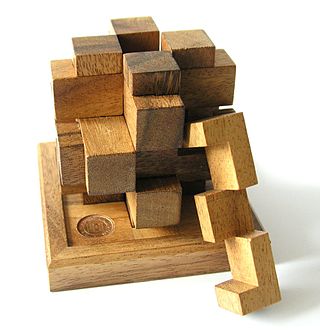
A mechanical puzzle is a puzzle presented as a set of mechanically interlinked pieces in which the solution is to manipulate the whole object or parts of it. While puzzles of this type have been in use by humanity as early as the 3rd century BC, one of the most well-known mechanical puzzles of modern day is the Rubik's Cube, invented by the Hungarian architect Ernő Rubik in 1974. The puzzles are typically designed for a single player, where the goal is for the player to discover the principle of the object, rather than accidentally coming up with the right solution through trial and error. With this in mind, they are often used as an intelligence test or in problem solving training.

The Rubik's Revenge is a 4×4×4 version of the Rubik's Cube. It was released in 1981. Invented by Péter Sebestény, the cube was nearly called the Sebestény Cube until a somewhat last-minute decision changed the puzzle's name to attract fans of the original Rubik's Cube. Unlike the original puzzle, it has no fixed faces: the center faces are free to move to different positions.

Optimal solutions for the Rubik's Cube are solutions that are the shortest in some sense. There are two common ways to measure the length of a solution. The first is to count the number of quarter turns. The second is to count the number of outer-layer twists, called "face turns". A move to turn an outer layer two quarter (90°) turns in the same direction would be counted as two moves in the quarter turn metric (QTM), but as one turn in the face metric.

Rubik's Magic, like the Rubik's Cube, is a mechanical puzzle invented by Ernő Rubik and first manufactured by Matchbox in the mid-1980s.
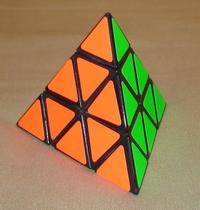
The Pyraminx is a regular tetrahedron puzzle in the style of Rubik's Cube. It was made and patented by Uwe Mèffert after the original 3 layered Rubik's Cube by Ernő Rubik, and introduced by Tomy Toys of Japan in 1981.

The Rubik's Clock is a mechanical puzzle invented and patented by Christopher C. Wiggs and Christopher J. Taylor. The Hungarian sculptor and professor of architecture Ernő Rubik bought the patent from them to market the product under his name. It was first marketed in 1988.

The Square-1 is a variant of the Rubik's Cube. Its distinguishing feature among the numerous Rubik's Cube variants is that it can change shape as it is twisted, due to the way it is cut, thus adding an extra level of challenge and difficulty. The Super Square One and Square Two puzzles have also been introduced. The Super Square One has two additional layers that can be scrambled and solved independently of the rest of the puzzle, and the Square Two has extra cuts made to the top and bottom layer, making the edge and corner wedges the same size.
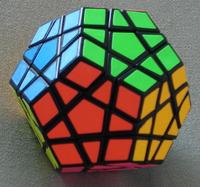
The Megaminx or Mégaminx is a dodecahedron-shaped puzzle similar to the Rubik's Cube. It has a total of 50 movable pieces to rearrange, compared to the 20 movable pieces of the Rubik's Cube.

A sliding puzzle, sliding block puzzle, or sliding tile puzzle is a combination puzzle that challenges a player to slide pieces along certain routes to establish a certain end-configuration. The pieces to be moved may consist of simple shapes, or they may be imprinted with colours, patterns, sections of a larger picture, numbers, or letters.

Perplexus, originally released as Superplexus, is a 3-D ball-in-a-maze puzzle or labyrinth game enclosed in a transparent plastic sphere. By twisting and turning it, players try to maneuver a small steel ball through a complex maze along narrow plastic tracks. The maze has many steps. The number of steps ranges from 30 in the Perplexus Twist to 225 in the Perplexus 3x3 Rubik's cube Hybrid. Some levels drop the ball into a cup or a small rim to utilize its 3-D nature. Players must complete obstacles varying in difficulty to reach the end.

Mickey's Ultimate Challenge is a puzzle video game developed by Designer Software and co-published by Walt Disney Computer Software and Hi Tech Expressions for the Super NES, Game Boy, Genesis/Mega Drive, Master System, and Game Gear. The Master System version, released in Brazil by Tectoy in 1998, was the last game released for that console. All other versions were released in 1994. Players move Mickey through the game by making him walk, jump, and go through doors. There are five major challenges, a segue, and a final challenge. It was met with mixed reviews from gaming magazines.
An annunciator panel, also known in some aircraft as the Centralized Warning Panel (CWP) or Caution Advisory Panel (CAP), is a group of lights used as a central indicator of status of equipment or systems in an aircraft, industrial process, building or other installation. Usually, the annunciator panel includes a main warning lamp or audible signal to draw the attention of operating personnel to the annunciator panel for abnormal events or condition.

A combination puzzle, also known as a sequential move puzzle, is a puzzle which consists of a set of pieces which can be manipulated into different combinations by a group of operations. Many such puzzles are mechanical puzzles of polyhedral shape, consisting of multiple layers of pieces along each axis which can rotate independently of each other. Collectively known as twisty puzzles, the archetype of this kind of puzzle is the Rubik's Cube. Each rotating side is usually marked with different colours, intended to be scrambled, then 'solved' by a sequence of moves that sort the facets by colour. As a generalisation, combination puzzles also include mathematically defined examples that have not been, or are impossible to, physically construct.

The V-Cube 6 is a 6×6×6 version of the original Rubik's Cube. The first mass-produced 6×6×6 was invented by Panagiotis Verdes and is produced by the Greek company Verdes Innovations SA. Other such puzzles have since been introduced by a number of Chinese companies, most of which have mechanisms which improve on the original. Unlike the original puzzle, it has no fixed facets: the center facets are free to move to different positions.
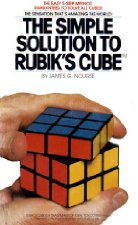
The Simple Solution to Rubik's Cube by James G. Nourse is a book that was published in 1981. The book explains how to solve the Rubik's Cube. The book became the best-selling book of 1981, selling 6,680,000 copies that year. It was the fastest-selling title in the 36-year history of Bantam Books.

The Pyraminx Duo is a tetrahedral twisty puzzle in the style of the Rubik's Cube. It was suggested by Rob Stegmann, invented by Oskar van Deventer, and has now been mass-produced by Meffert's.
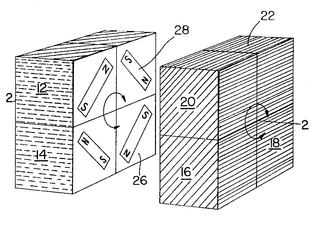
Larry D. Nichols, born 1939 in the United States, is a puzzle designer. He grew up in Xenia, Ohio, and studied chemistry at DePauw University in Greencastle, Indiana, before moving to Massachusetts to attend Harvard Graduate School. He is best known for the invention of mechanical puzzles including 'The Nichols Cube Puzzle' (1974), patent US365520. He has lived with his wife Karen in Arlington, Massachusetts since 1959.

The Gear Cube is a 3-D combination puzzle designed and created by Dutch puzzle maker Oskar van Deventer based on an idea by Bram Cohen. It was initially produced by Shapeways in 2009 and known as "Caution Cube" due to the likelihood of getting one's fingers stuck between the gears while speedcubing. Later, in 2010, it was mass-produced by Meffert's as the "Gear Cube".

The Dino Cube is a cubic twisty puzzle in the style of the Rubik's Cube. It was invented in 1985 by Robert Webb, though it was not mass-produced until ten years later. It has a total of 12 external movable pieces to rearrange, compared to 20 movable pieces on the Rubik's Cube.